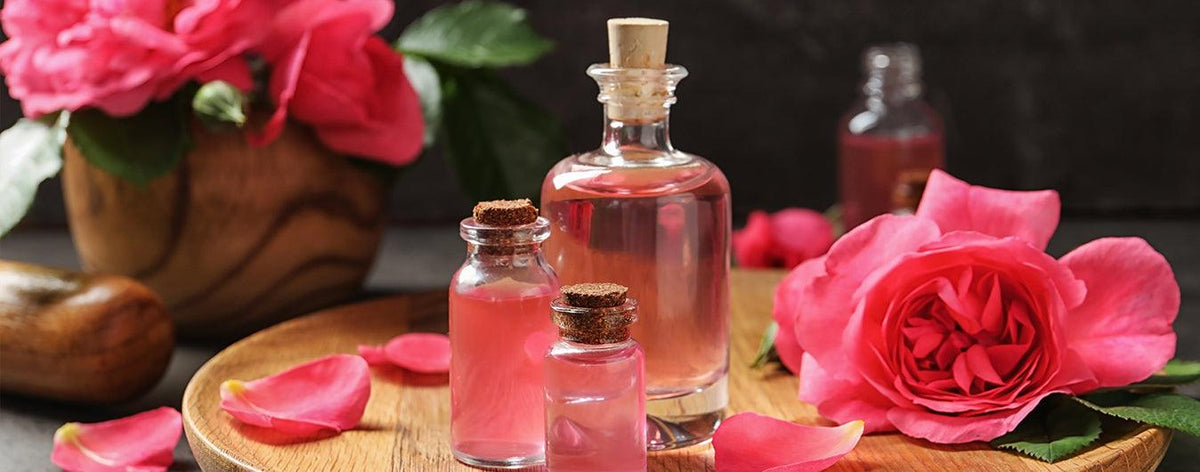রোজ অয়েল

গোলাপ তেলের উপকারিতা ও বৈশিষ্ট্য
- গোলাপ (ফ্যামিলি রোসেসি) হল সবচেয়ে জনপ্রিয় এবং বহুল ব্যবহৃত ঔষধি গাছ। (সাফিহ মোহেবিতাবার ও ফাতেমেহ নেজাতবখশ, 2017)
- ফার্সি মেডিসিন অনুসারে, গোলাপ তেলের প্রদাহ বিরোধী, সংক্রামক বিরোধী এবং ক্ষত নিরাময় ক্রিয়াকলাপ রয়েছে। (সাফিহ মোহেবিতাবার ও ফাতেমেহ নেজাতবখশ, 2017)
- এটি সব ধরনের ত্বকের জন্য উপযুক্ত কিন্তু বিশেষ করে পরিপক্ক, শুষ্ক, সংবেদনশীল এবং বার্ধক্যজনিত ত্বকের জন্য। (বিক্রেতা, 1992)
- গালের লালভাব কমাতে এটি বর্ধিত কৈশিকগুলির উপর একটি টনিক এবং অ্যাস্ট্রিঞ্জেন্ট প্রভাব ফেলে। (বিক্রেতা, 1992), (ডেভিস, 1988)
- গোলাপ তেল কিছু অ্যালার্জির জন্য সহায়ক। (Anton C. de Groot, 2016)
- গোলাপ তেলের রাসায়নিক সংমিশ্রণে সিট্রোনেলল, জেরানিওল, নেরোল, স্টিয়ারপোটেন, ফিনাইল ইথানল এবং নননাল লিনালুলের চিহ্ন রয়েছে। (স্নেহাল এস কুলকার্নি, 2014)
- এটি UV রশ্মির অনুপ্রবেশের বিরুদ্ধে কাজ করে। (স্নেহাল এস কুলকার্নি, 2014)
- রোজ এসেনশিয়াল অয়েলের অ্যান্টিঅক্সিডেন্ট বৈশিষ্ট্যগুলির মধ্যে রয়েছে জেরানিওল, লিনালুল এবং সিট্রোনেলল ফ্রি র্যাডিকেলগুলি ধ্বংস করতে গুরুত্বপূর্ণ ভূমিকা পালন করে। (মিচালক, 2022)
- অ্যান্টিব্যাকটেরিয়াল বৈশিষ্ট্য সহ, এটি প্রায়শই ব্রণ চিকিত্সার জন্য সুপারিশ করা হয়। (আসজা সার্কিক, 2018)
- এটি হৃদয়কে উত্তোলন করে এবং স্নায়বিক উত্তেজনা ও চাপকে সহজ করে। (বিক্রেতা, 1992)।
- ফ্ল্যাভোনয়েড এবং ফ্রি র্যাডিক্যাল অ্যান্টিঅক্সিডেন্ট যৌগ যেমন রুটিন এবং কোয়ারসেটিন বিষণ্নতার চিকিৎসায় সহায়ক। (মোস্তফা নাজিরোগলু, 2012)
- এটি কিছু পরিমাণে বমি বমি ভাব, বমি এবং কোষ্ঠকাঠিন্য থেকে মুক্তি দেয় এবং গলা ব্যথায় প্রশান্তিদায়ক প্রভাব ফেলে এবং কাশি সহজ করে। (বিক্রেতা, 1992)
- এটি হ্যাপি হরমোন ডোপামাইন নিঃসরণ করতে সাহায্য করে, যা বন্ধ্যাত্বের উপকার করে এবং পুরুষদের যৌন সমস্যায় সহায়তা করে। (বিক্রেতা, 1992)
- মাসিক চক্র নিয়ন্ত্রণ এবং অত্যধিক ক্ষতি কমানোর জন্য মহিলাদের জন্য উপযুক্ত। (ডেভিস, 1988)
- রোজ অয়েল জরায়ুতে শক্তিশালী প্রভাব ফেলে এবং গর্ভপাতের প্রবণতা থাকা মহিলাদের জন্যও এটি উপযুক্ত। (ডেভিস, 1988)
রোজ অয়েল
রোজ অয়েল তথ্য:
INCI: Rosa Damascene ফ্লাওয়ার অয়েল। (Anton C. de Groot, 2016)
এটির মতো-ও বলা হয়: ডামাস্ক রোজ ফ্লাওয়ার অয়েল।
অ্যাকশন: অ্যান্টিঅক্সিডেন্ট, পারফিউমিং, অ্যান্টিব্যাকটেরিয়াল/ অ্যান্টিমাইক্রোবিয়াল, অ্যান্টিডিপ্রেসেন্ট, অ্যান্টিফ্লোজিস্টিক, অ্যান্টিস্পাসমোডিক। (মোহাম্মদ হোসেন বোসকাবাদি, 2011), (আইনহীন, 1992)
অন্যান্য: রোজা সেন্টিফোলিয়া (বাঁধাকপি গোলাপ)।
রোজা গ্যালিকা (লাল গোলাপ) (বিক্রেতা, 1992)
পরিবার: Rosaceae. (বিক্রেতা, 1992)
CAS নম্বর(গুলি): 8007-01-0; 90106-38-0। (Anton C. de Groot, 2016)
কোসিং তথ্য:
সমস্ত ফাংশন: মাস্কিং, ত্বকের কন্ডিশনিং।
বর্ণনা: Rosa damascene ফ্লাওয়ার অয়েল হল damask rose, Rosa damascene এবং Rosaceae এর ফুল থেকে প্রাপ্ত উদ্বায়ী তেল। (Anton C. de Groot, 2016)
সুবাস: গভীর, মিষ্টি এবং ফুলের- একটি সূক্ষ্ম সুগন্ধি। (বিক্রেতা, 1992)
রঙ: একটি ফ্যাকাশে হলুদ বা জলপাই-হলুদ তরল। (আইনহীন, 1992)

গোলাপ সম্ভবত প্রথম ফুল যেখান থেকে দশম শতাব্দীর পারস্যে অপরিহার্য তেল পাতিত হয়েছিল। মহান আরব চিকিত্সক অ্যাভিসেনা প্রথম রোজ অয়েল, সম্ভবত দৈবক্রমে, আলকেমিক্যাল পরীক্ষার সময় পরিশোধন করে তৈরি করা হয়েছিল। (ডেভিস, 1988)। এটি প্রাচ্যের একটি খুব জনপ্রিয় উদ্ভিদ: পারস্য যোদ্ধারা তাদের ঢাল লাল গোলাপ দিয়ে সজ্জিত করেছিল, তুর্কিরা এটি চালু করেছিল এবং বিজয়ী তুর্কিরা এটি 17 শতকে বুলগেরিয়াতে প্রবর্তন করেছিল। রোজা গ্যালিকা মধ্যযুগে ফুসফুসের রোগ এবং হাঁপানি নিরাময়ের জন্য ব্যবহৃত হত। দ্বিতীয় বিশ্বযুদ্ধের সময় ভিটামিন সি কম সরবরাহ ছিল এবং এর পরিবর্তে রোজশিপ ব্যবহার করা হয়েছিল (সেলার, 1992)।

দামস্ক গোলাপ, ইরানে গোল মোহাম্মদী নামেও পরিচিত। এটি Rosaceae পরিবারের অন্যতম গুরুত্বপূর্ণ প্রজাতি। এগুলি হল সুপরিচিত শোভাময় গাছ যাকে ফুলের রাজা বলা হয়। 200 টিরও বেশি গোলাপের প্রজাতি এবং উদ্ভিদের 18000 টিরও বেশি জাত শনাক্ত করা হয়েছে। এটি প্রধানত এর সুগন্ধি প্রভাবের জন্য পরিচিত। বিবাহে গোলাপ জল ছড়িয়ে দেওয়া ভালবাসা এবং বিশুদ্ধতার প্রতীক এবং এটি ধ্যান ও প্রার্থনায় সহায়তা করার জন্যও ব্যবহৃত হয়। (মোহাম্মদ হোসেন বোসকাবাদী এমএন, 2011)
গোলাপ (ফ্যামিলি রোসেসি) সবচেয়ে জনপ্রিয় এবং বহুল ব্যবহৃত ঔষধি উদ্ভিদ। তারা মধ্যপ্রাচ্য থেকে উদ্ভূত কিন্তু সারা বিশ্বে চাষ করা হয়। রোজ অয়েল হল রোজা প্রজাতির পাপড়ি, বিশেষ করে R. damascena এবং R. centifolia থেকে নিষ্কাশিত অপরিহার্য তেল। বর্তমানে, বুলগেরিয়া, তুরস্ক এবং মরক্কো এই অপরিহার্য তেলের প্রধান উৎপাদনকারী দেশ। (সাফিহ মোহেবিতাবার ও ফাতেমেহ নেজাতবখশ, 2017)
ইরানের কাশান অঞ্চলে R. damascena অপরিহার্য তেলের উপর একটি গবেষণায়, 95 টি উপাদানের রিপোর্ট করা হয়েছে। সর্বাধিক প্রচুর পরিমাণে ছিল β-সিট্রোনেলল, ননডেকেন, জেরানিওল। (Anton C. de Groot, 2016), (Safieh Mohebitabar & Fatemeh Nejatbakhsh, 2017)।
ফার্সি মেডিসিনে, গোলাপ তেলের প্রদাহ বিরোধী, সংক্রামক বিরোধী এবং ক্ষত নিরাময়কারী কার্যকলাপ রয়েছে বলে অভিযোগ করা হয়েছে। এটি মাথাব্যথা, গ্যাস্ট্রোইনটেস্টাইনাল ট্র্যাক্টের প্রদাহজনক অবস্থা এবং পেশী ব্যথা উপশমের জন্য ব্যবহৃত হয়েছে। (সাফিহ মোহেবিতাবার ও ফাতেমেহ নেজাতবখশ, 2017)
গোলাপের তেলের শ্বাস-প্রশ্বাস পুরুষ প্রজনন ব্যবস্থায় ফর্মালডিহাইড ( বর্ণহীন, দাহ্য, তীব্র-গন্ধযুক্ত রাসায়নিক ) এর সংস্পর্শে সৃষ্ট ক্ষতির বিরুদ্ধে প্রতিরক্ষামূলক প্রভাব দেখায়। (সাফিহ মোহেবিতাবার ও ফাতেমেহ নেজাতবখশ, 2017)
রোজ এসেনশিয়াল অয়েল সহ আমাদের পণ্য
রিল্যাক্সিং ফ্লোরাল বডি অয়েল, ল্যাভেন্ডার এবং রোজ বডি ম্যাসাজ অয়েল, স্কিন হাইড্রেটিং রোজ টোনার এবং 32 স্টার ব্লেন্ডেড এসেনশিয়াল অয়েল উচ্চ মানের, বিশুদ্ধ রোজ এসেনশিয়াল অয়েলের সঠিকতার সাথে চালিত। রোজ এসেনশিয়াল অয়েল একটি সূক্ষ্ম প্রক্রিয়ায় ফুলের তাজা পাপড়ি থেকে পাওয়া যায়। এটি তীব্র ময়শ্চারাইজিং এবং শুষ্ক, পরিপক্ক, শক্ত এবং সংবেদনশীল ত্বকের জন্য চমৎকার। এটি লালভাব এবং প্রদাহের বিরুদ্ধে লড়াই করে এবং আর্দ্রতা শোষণ ও ধরে রেখে ত্বকের কোষগুলিকে শক্তিশালী করে। এর টনিক এবং প্রশান্তিদায়ক গুণ কৈশিকগুলির উপর সংকুচিত ক্রিয়া করতে সহায়তা করে এবং ভাঙ্গা থ্রেড শিরাগুলির জন্য একটি মূল্যবান চিকিত্সা। আল্ট্রা-ফেমিনিন তেল একজন মহিলাকে নিজের সম্পর্কে ইতিবাচক অনুভূতি দেয়। গর্ভ, শান্ত, এবং মাসিক উদ্বেগের জন্য চমৎকার। এটা ইচ্ছা অনুভূতি অনুপ্রাণিত স্বনামধন্য.
বিশেষ করে যারা সারা বছর বডি অয়েল ব্যবহার করতে চান তাদের জন্য ডিজাইন করা হয়েছে। এই বিষয়টি মাথায় রেখে, সামার ফ্লোরাল নোট সহ মহিলাদের জন্য একটি অনন্য ফর্মুলা তৈরি করা হয়েছে। মিষ্টি, পুষ্পশোভিত এবং বহিরাগত সুবাস, নন-স্টিকি, হালকা, দ্রুত শোষণকারী এবং পুষ্টিকর তেল ল্যাভেন্ডার, রোজ এবং ইলাং ইলাং এসেনশিয়াল অয়েল এবং জোজোবা তেলের একটি অনন্য সংমিশ্রণের সাথে মিশ্রিত। এটি প্রশান্তিদায়ক এবং শীতল প্রভাব এবং একই সাথে ত্বকে আর্দ্রতা ধরে রাখতে সহায়তা করে।
বিশেষত মেয়েলি সুবাস এবং বৈশিষ্ট্য সহ মহিলাদের জন্য ডিজাইন করা হয়েছে। এটি শান্ত এবং প্রশান্তিদায়ক। দারুণ স্কিন টনিক। এটিতে রোমান্টিক বৈশিষ্ট্য রয়েছে। ল্যাভেন্ডার এবং রোজ বডি ম্যাসেজ অয়েল হল একটি হালকা, নন-স্টিকি এবং দ্রুত-শোষক তেল যা ত্বকের স্থিতিস্থাপকতা, টেক্সচার এবং টোন উন্নত করে এবং তাত্ক্ষণিক আভা দেয়। স্নানের পরে এবং বিছানায় যাওয়ার আগে ব্যবহারের জন্য।